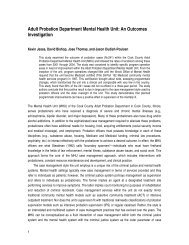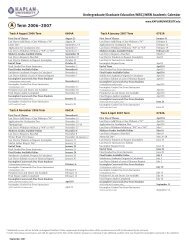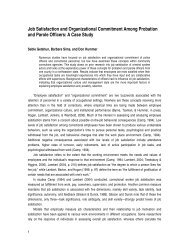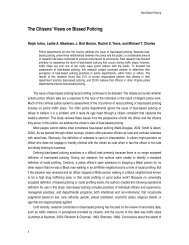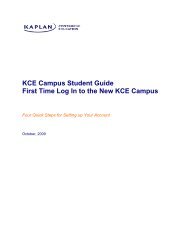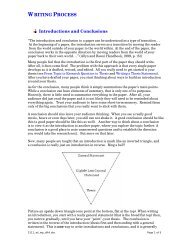Police Officer - Kaplan University | KU Campus
Police Officer - Kaplan University | KU Campus
Police Officer - Kaplan University | KU Campus
Create successful ePaper yourself
Turn your PDF publications into a flip-book with our unique Google optimized e-Paper software.
<strong>Police</strong> <strong>Officer</strong> Recruitment<br />
Reliability Analysis<br />
To assess the internal consistency of the two items serving as an additive composite<br />
score for the dependent variable (job rating), the researcher computed coefficient alpha<br />
for the composite score (Table 2). Coefficient alpha for the two-item scale measuring job<br />
rating was .93. This value indicates a strong internal consistency.<br />
Table 2. Reliability Analysis for Dependent Variable (N = 277)<br />
Item<br />
Scale Mean if<br />
Item Deleted<br />
Scale Variance<br />
if Item Deleted<br />
Corrected Item<br />
Total Correlation<br />
Squared<br />
Multiple<br />
Correlation<br />
1 3.838 1.195 .865 .749<br />
2 4.000 1.000 .865 .749<br />
Note. Item Code: 1 = Likelihood of accepting an interview for the job; 2 = Likelihood of<br />
accepting the job if offered. Coefficient alpha was computed to assess the internal<br />
consistency for the two-item 5-point scale measuring the dependent variable (job<br />
rating).The coefficient alpha of .93 far exceeds the magnitude recommended for use in a<br />
composite scale statistical analysis.<br />
Inferential Statistical Analysis<br />
The cell means and standard deviations appear in Table 3. The next step in the analysis<br />
was to compute the three-way ANOVA results that appear in Table 4.<br />
As the data in Table 3 show, the magnitudes of the cell means were very similar,<br />
suggesting the ANOVA might not yield significant effects. The data from the ANOVA<br />
shown in Table 4 confirmed there were no significant main or interaction effects.<br />
In designing the experiment conducted for this exploratory research, the researcher<br />
made three assumptions: (a) a residency requirement would be a disincentive to potential<br />
job applicants; (b) the opportunity for job specialization would be a positive incentive to<br />
potential job applicants; and (c) the opportunity for educational reimbursement would be a<br />
positive incentive to potential job applicants. As the ANOVA results demonstrate, the<br />
actual participant reactions to the research protocols did not support the above<br />
assumptions.<br />
Professional Issues in Criminal Justice Vol 4(3 & 4), 2009 75



